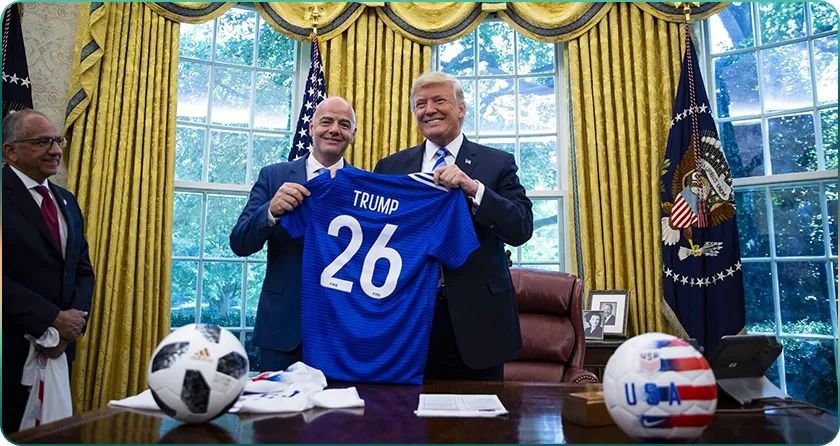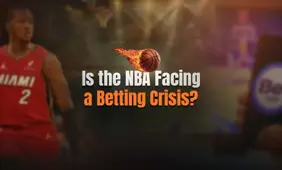Club World Cup 2025: Could This Tournament Finally Make Soccer Big in the U.S.?

In mid-June, under the blazing Miami sun and the corporate glow of Fox Sports promos, something quietly remarkable is happening: the world’s biggest ever club football tournament – FIFA’s revamped Club World Cup – is being staged on American soil for the first time. Teams like Real Madrid, Manchester City, PSG and, erm, Auckland City are here not for preseason friendlies or novelty tours, but for high-stakes matches that actually count.
It’s a dry run of sorts. Next year, the U.S. will co-host the men’s World Cup for the first time since 1994. But this summer's Club World Cup presents something even more intriguing: a litmus test that might give us some indication as to whether Americans are finally ready to fall in love with the beautiful game, not just once every four years, but on a more permanent basis.
This isn’t just a sporting experiment; it’s a cultural gamble, with massive implications for media companies, sportsbooks, streaming platforms, and political power players. Already, sportsbooks are ramping up their soccer offerings. The FIFA president, Gianni Infantino, has been spotted cozying up to President Trump, while Cristiano Ronaldo just sent Trump a signed Portugal jersey inscribed with a message calling for world peace. Behind the spectacle, there’s an unmistakable play for influence.
And at the heart of it all lies a simple, unresolved question: can soccer – the global, beautiful, chaotic sport that the rest of the world calls football – finally crack the American psyche?
The answer may rest not just in stadiums, but in betting slips, political handshakes and TikTok highlight reels. Welcome to the FIFA Club World Cup. It might be an overblown cash-grab that no fans or players actually care about, or it might be the start of something much bigger.
A Short History of America’s Soccer Problem
For decades, America’s relationship with soccer has been less a love affair and more a polite tolerance. Despite being the world’s most popular sport, soccer has struggled to gain traction in a country where baseball, basketball, hockey and American football reign supreme.
The 1994 World Cup, hosted by the U.S., was supposed to change everything. It generated record crowds and helped catalyze the creation of Major League Soccer (MLS) two years later. But while MLS has grown steadily, especially in recent years with the arrival of global stars like Lionel Messi, soccer has remained, at best, a niche passion in a crowded ecosystem of all-American sports.
Part of the problem has always been visibility. Before the internet era, watching top-tier European matches required obscure satellite channels and Sunday morning dedication. Domestic leagues lacked star power, and even the U.S. men’s national team, never a serious contender for the World Club Cup, failed to give casual fans something to truly rally behind.
Betting didn’t help either. Sportsbooks in the pre-legalization era mostly ignored soccer, focusing instead on NFL point spreads, March Madness brackets, and MLB money lines. The intricacies of soccer – low scores, limited stat lines, and matches that could end in a draw – weren’t well suited to American betting preferences, which leaned toward high-action, high-volume wagers.
But things are shifting. Today, global streaming has made Premier League and Champions League games as accessible as NFL RedZone. Sportsbooks, now legal in over 30 states, routinely feature soccer matches with rich market depth. And younger fans, raised on FIFA video games and Messi vs Ronaldo memes, are bringing a new cultural literacy to the sport.
Yet even with these tailwinds, the perception lingers: soccer is foreign, low-scoring and, in the eyes of many Americans, boring. This FIFA Club World Cup 2025, however, offers a different proposition. It’s not national teams with unfamiliar players: it’s club legends who Americans have seen on TikTok, in Fortnite skins, and on YouTube highlight compilations. It might be exactly the tournament U.S. soccer needs.
Club World Cup & Betting on Soccer: A Quiet Revolution
After the U.S. Supreme Court removed PASPA in 2018, legal sports betting started to change the gambling market across the country. More than 30 states now allow sports betting, and the rise of USA online casino sites has added even more growth. Soccer has slowly become a steady part of what operators offer, even though few expected it. For years, the NFL, NBA, and college sports held most of the attention, leaving soccer far behind.
Yet five years on, the picture looks very different.
Soccer is now the fourth most-bet-on sport in the U.S., according to several leading operators, with marquee matches from the Premier League, Champions League and La Liga drawing substantial betting volume. For global sportsbooks like bet365, FanDuel, and DraftKings, the sport has gone from a soft offering to a pillar of year-round engagement. The 2022 FIFA World Cup in Qatar gave many Americans their first taste of meaningful soccer betting on goal scorers, corners, cards, and intricate same-game parlays. It also didn’t hurt that Lionel Messi, probably the most recognizable footballer in the world, lifted the trophy at the end of it all, just a year before his transfer to Inter Miami was announced.
What’s more, soccer’s structure is uniquely suited to the modern betting economy. With games played nearly every day across the globe, it provides a constant stream of markets, particularly valuable during the quieter months of the U.S. sporting calendar. Add in the appeal of in-play betting, where odds change with every pass and free kick, and soccer becomes an ideal sport for mobile-first gamblers.
The rise of micro betting- placing wagers on individual events within games, on markets such as “Will there be a corner in the next five minutes?” – has further entrenched soccer within sportsbooks. Soccer’s fluid, clock-driven pace lends itself better to these short-term bets than more stop-start American sports.
The Club World Cup 2025 adds another layer of intrigue. Though historically a minor tournament in global terms, its new expanded format and placement in the U.S. market give American fans and sportsbooks alike a new product to test. It's a preview of the 2026 World Cup, but more importantly, it’s a club-based tournament, which may resonate more with American bettors who follow Messi’s Inter Miami or Kylian Mbappé’s Real Madrid than, say, the Portuguese national team.
Betting may not single-handedly make Americans fall in love with soccer, but it does offer some kind of stake in the game. And when money is on the line, emotional investment often follows. For sportsbooks, it’s not just about capitalizing on the World Cup bump; it’s about making soccer stick.

Infantino, Trump and the Politics Behind FIFA Club World Cup
For all the talk of tactics, talent and television rights, football’s global expansion is as much a political project as it is a sporting one. Nowhere is this more apparent than in FIFA president Gianni Infantino’s increasing investment – both literal and figurative – in the United States.
Infantino has made no secret of his ambitions. Under his watch, FIFA has pushed through some of the most controversial reforms in recent memory: an expanded 48-team World Cup, an overhauled Club World Cup schedule with 32 teams, and a more aggressive calendar that has frustrated many people in the domestic European leagues. What ties all of these developments together is their orientation toward the North American market, which Infantino views as football’s last great frontier.
In that context, the U.S.-hosted Club World Cup in 2025 is not just a warm-up for the main event in 2026; it’s also a political litmus test. Can FIFA successfully rebrand itself from a corrupt oligarchy to a sports visionary on American soil? Can the governing body embed football in the U.S. cultural psyche not just as a global curiosity, but as a permanent fixture?
The optics of this campaign are complicated. On several occasions, Infantino has been photographed with Trump, who, as president, welcomed the FIFA boss to the White House and celebrated the U.S.-Mexico-Canada World Cup bid win. In June, Trump received a signed jersey from Cristiano Ronaldo, accompanied by a handwritten note about “world peace”. Whether this was a sincere diplomatic gesture or a carefully orchestrated PR stunt, it underscores the geopolitical oddity of football’s American moment: the world’s most global sport is, paradoxically, being sold back to the U.S. via the language of nationalism and soft power.
Critics see Infantino’s relationship with Trump – and his general coziness with authoritarian-leaning figures – as a red flag. Supporters argue that FIFA needs political muscle to penetrate American exceptionalism, and that cozying up to power is just part of the game.
For American fans and bettors, these political moves may seem irrelevant. But they shape everything: the tournaments that get prioritized, the clubs that receive attention, the markets that open up for wagering. If soccer is going to become a major part of American life, it will not be through grassroots development alone; it will be, as always, a negotiation between sport, capital and politics.
The Changing American Fan: From Spectator to Stakeholder
To understand why soccer might finally be on the cusp of mainstream American acceptance, it helps to consider the transformation of the American sports fan: not just in what you watch, but in how you engage.
Today’s fan is not a passive viewer. Thanks to fantasy leagues, sports betting apps and real-time stats feeds, fandom is now transactional. The act of watching a match is often accompanied by a bet, a lineup adjustment, or a stock-like wager on a player's performance. As this trend intensifies, sports that offer frequent outcomes – goals, cards, corners, player props – become more attractive. Enter soccer, a sport that once seemed too slow and low-scoring for American tastes, now rebranded as a data-rich betting playground.
Soccer’s U.S. footprint isn’t uniform – it thrives in some states while barely registering in others. Our latest analysis, conducted using Google Trends data for “Club World Cup” and related terms, reveals where the sport’s pulse beats strongest.
Top U.S. States with the Highest Interest in Club World Cup (2025):
- 1. New Jersey
- 2. California
- 3. Florida
- 4. Maryland
- 5. Washington
At the other end of the spectrum, these five states show the faintest heartbeat for the tournament and soccer in general.
Top 5 U.S States with the Least Interest in Club World Cup (2025):
- 1. West Virginia
- 2. Mississippi
- 3. Montana
- 4. Louisiana
- 5. South Dakota
Whether due to entrenched preferences for homegrown sports or limited exposure to international fixtures, these states remain on the periphery of soccer’s American rise.
If you take DraftKings and FanDuel, which have aggressively expanded their soccer offerings in the past two years, both now provide extensive in-game markets for MLS, Premier League, Champions League and international tournaments. For the Club World Cup, you can bet on not just the final score but things like total shots, possession percentages and the timing of a team’s first substitution. This granularity appeals to data-driven bettors, especially younger ones, who approach gambling less like a gut feeling and more like an algorithm.
The shift isn’t just technological; it’s generational. Gen Z and millennials, many of whom grew up playing FIFA on consoles or following European clubs via TikTok, are already accustomed to soccer's rhythms, reflecting broader evolutions in gambling preferences across generations. For them, placing a live bet during a Palmeiras vs. Manchester City match feels no more foreign than a wager on an NFL kickoff return.
This evolution blurs the line between fan and investor. American bettors are increasingly staking not just money but emotional capital on matches halfway across the globe. A viewer’s relationship to the sport is less tribal and more tactical, a shift from the traditional “ride or die” loyalty of legacy fandom to a marketplace of opportunity.
And with micro betting gaining traction – bets on what will happen in the next minute of play – soccer may prove an ideal canvas. The pace allows just enough time to place bets, but not so much that the action drags. In this sense, American fans aren't just warming to soccer. They're shaping a new way of watching it, one bet at a time.
Club World Cup 2025 and U.S. Soccer Betting
More than just a soft launch for next year’s FIFA World Cup, the 2025 Club World Cup is a proving ground for how American audiences will interact with global football in a high-stakes, data-rich, betting-enabled environment. In many ways, it’s also a test case for sportsbooks and media companies eager to see how a major international tournament lands in the most competitive sports market in the world.
For operators, this summer’s World Club Cup offers a rare opportunity. It’s a FIFA-run tournament featuring 32 teams, including global powerhouses like Real Madrid, Manchester City, and Flamengo. Crucially, many of the participating clubs have enormous followings in Latin America, Africa, and Asia, diaspora communities that are significantly under-tapped by traditional U.S. sportsbooks. By offering betting markets on every match, down to granular live-play props, bookmakers are experimenting with how to capture a wider slice of the American sports betting public.
Expect to see operators test tailored promotions: boosted odds on the biggest matchups, same-game parlays featuring household-name players, and bilingual interfaces designed to cater to multilingual audiences. In this way, the Club World Cup becomes a sandbox for expanding not just soccer’s cultural footprint, but the architecture of soccer betting itself.
There’s also the matter of timing. Held in summer, the Club World Cup fills a relatively quiet period in the American sports calendar, arriving just after the NBA Finals and ahead of the NFL preseason. This creates an uncluttered media environment where soccer can be framed not as an exotic import, but as a headline event. And sportsbooks are already preparing accordingly, ramping up content offerings and ad campaigns to hook new bettors before next year’s World Cup boom.
Importantly, the structure of the Club World Cup – short tournament, global stakes, familiar players – mirrors the kind of event Americans already like to bet on: March Madness, the NFL Playoffs, the World Cup itself. There’s a clear narrative arc, a tight window for wagering, and high emotional payoff. If sportsbooks can convert first-time Club World Cup bettors into long-term soccer customers, it may mark a turning point for the sport’s financial future in the US.

Politics Behind the Pitch
While the Club World Cup is a test of sporting and commercial appetite, it’s also a display of soft power. And FIFA knows it. Gianni Infantino, FIFA’s president and architect of the expanded tournament, has spent the past year cultivating ties in the U.S. political ecosystem. Most notably, he’s been seen publicly with Donald Trump on multiple occasions, the two of them posing for photos inside the Oval Office. The messaging is clear: FIFA wants American buy-in.
It’s part of a broader trend: football is no longer just a game; it’s a tool for diplomacy, branding, and global influence. Hosting the Club World Cup offers the U.S. a chance to demonstrate its readiness for the 2026 World Cup, while FIFA positions itself as a unifying force across political lines. But that comes with baggage. Critics have long argued that FIFA’s expansion of tournaments prioritizes revenue over player welfare or fan accessibility. And Infantino’s closeness with polarizing figures like Trump only sharpens those concerns.
Still, for American soccer – and sports betting – the political theatre may be a footnote to a larger transformation. With betting markets opening up, a growing youth fanbase, and soccer-friendly time zones during the tournament, the real power might lie not in FIFA’s handshakes but in fans’ betting slips.



Review this Blog
Leave a Comment
User Comments
comments for Club World Cup 2025: Could This Tournament Finally Make Soccer Big in the U.S.?